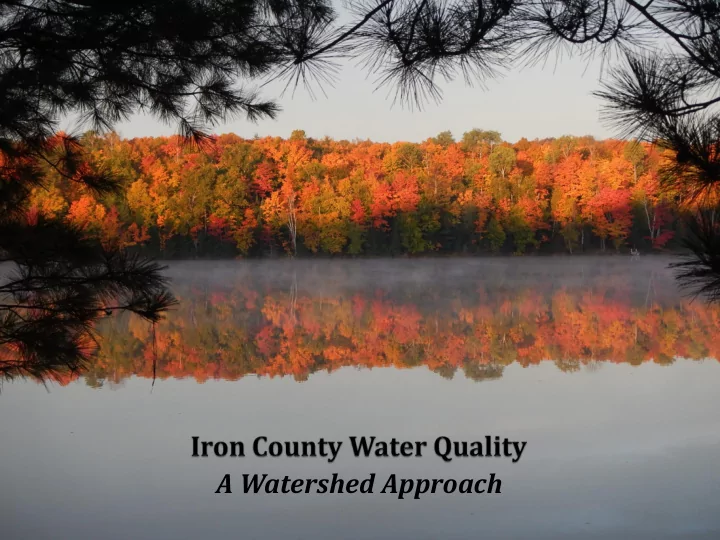

A Watershed Approach
Iron County Watershed Coalition Iron County Lakes & Streams Partnership Baraga-Iron Conservation District MDEQ, USFS, MDNR White Water Associates, Inc.
OVERVIEW Why should we care about water quality? • Why is our water special? • What is a watershed? • What are the threats to our watersheds? • How can we help? •
Why should we care about water quality?
Our Water Quality is Changing Faster than Ever • Groundwater pollution • Destruction of shoreline habitat • Lake and stream pollution and invasive species
Our county’s fresh water is rare 71% Earth’s surface covered by water • <1% Water on earth is freshwater • There are over 220 lakes and 200 miles of • river on Iron County watersheds. All of Iron County depends on groundwater • in our watersheds for drinking water
What is a Watershed? A watershed is an area of land that contains a common set of streams, rivers and lakes that all drain into a single larger body of water. Iron County has seven major watersheds These watersheds drain into Lake Superior, Lake Michigan or the Mississippi River A person in Iron County is never more than 2-1/2 miles from a lake, river, stream, creek or pond.
We live on and influence the watershed
Lake Habitat Zones Riparian Area Littoral Zone Limnetic Zone (open water)
90% of all lake life is born, raised, and fed in the area where land and water meet. (Ontario Ministry of Natural Resources)
Lake Littoral Zone Functions include: • Intercepts Nutrients • Refuge from Predators • Nursery for Fish • Highly productive of plants and invertebrates Oligotrophic Northern Lake Eutrophic Southern Lake
Features of Littoral Zone Habitat • Vegetation • Substrate • Woody cover • Overhanging bank cover • Depth and depth gradients
Riparian Area • Filters runoff • Contributes wood & other organic material • Where we live & recreate
Threats to Lakes and Streams • Poor lakeshore habitat (riparian vegetation) is the number one stressor of lake ecosystems. • Poor littoral zone habitat is number two. The 2007 National Lakes Assessment
Threats to Groundwater • Leaking underground and above ground storage tanks – gasoline, heating oil, solvents • Unsuitable or ineffective septic systems • Intensive use of fertilizers, pesticides and herbicides • Point Sources • Improper disposal practices • Old landfills
How can we help? • Be aware of your drinking water source and where it comes from. • Be aware of your septic system and where it goes • Be aware of all applications and disposal of chemicals on the ground and the potential effects. • By managing for healthy lake shores (both littoral and riparian), we can make a difference in lake and stream biological integrity (health). • Monitor the water you drink and play in. Know and understand the health of your watershed.
Recommend
More recommend